Texx
Super Moderator
EFI Diagnosis system description
The ECU contains a built in, self-diagnosis system which detects faults within the engine signal network. When the system detects a fault the "CHECK" engine warning lamp in the instrument panel will illuminate.
By analyzing various signals the ECU detects system malfunctions which are related to the various operating parameters of the systems sensors and actuators. The ECU stores fault codes that are associated with the detected malfunctions until the diagnosis system is reset by removing the EFI fuse with the ignition OFF.
An illuminated "CHECK" engine warning lamp in the instrument panel informs the driver that a system malfunction has been detected. The lamp goes out automatically when the malfunction has been cleared.
"CHECK" Engine warning lamp check
The "CHECK" engine warning lamp will illuminate when the ignition switch is in the ON position and the engine is not running.

When the engine is started, the "CHECK" engine warning lamp should go out.
If the lamp remains illuminated, the diagnosis system has detected a system malfunction or abnormality.
Output of Diagnostic Fault Codes
To obtain an output of any stored diagnostic fault codes, proceed as follows:
Initial conditions:
Turn the ignition switch to the ON position without starting the engine.
Short terminals TE1 and E1 of the diagnostic check connector.
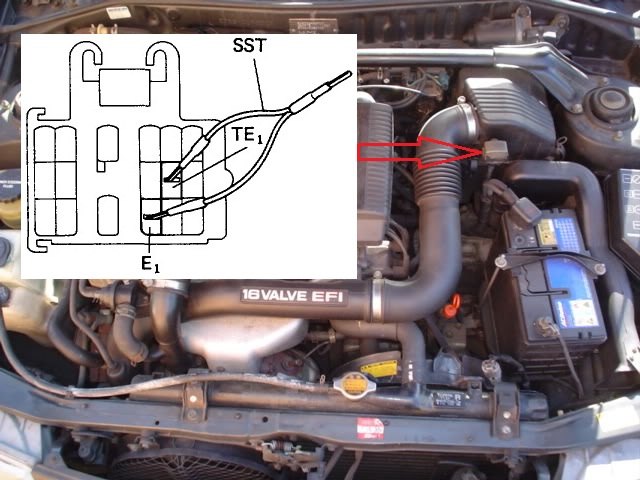
Read the diagnostic fault codes as indicated by the number flashes of the "CHECK" engine warning lamp.
Normal system operation (no malfunction detected) will be indicated by the "CHECK" engine warning lamp flashing ON and OFF twice per second.
In the event of one or more malfunctions being detected, the "CHECK" engine warning lamp will blink every 0.5 of a second. The first number of blinks will equal the first digit of a 2-digit diagnostic fault code, after 1.5 second pause, the 2nd number of blinks will equal the 2nd digit of the diagnostic fault code. If there are two or more codes stored, there will be a 2.5 second pause between each code signaled.
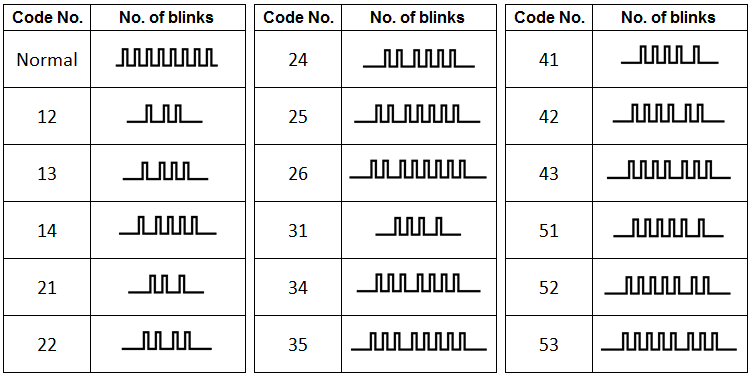
After all codes have been signaled there will be a 4.5 second pause and then they will be repeated as long as the terminals TE1 and E1 of the check connector are shorted and the ignition switch remains in the ON position.
In the event of several diagnostic fault codes being stored, the indication will begin from the code with the smaller value and continue in order to the larger.
After the diagnostic check has been completed, remove the short between terminals TE1 and E1 of the check connector and turn the ignition switch to the OFF position.
Cancelling Diagnostic Fault Codes
After the repair of a troubled area, the diagnostic fault codes retained in memory by the ECU must be cleared by removing the fuse "EFI 15A" for 10 seconds or more, depending on ambient temperature (the lower the temperature, the longer the fuse must be left out) with the ignition switch in the OFF position.
Clearing the memory of the ECU can also be done by removing the vehicle battery negative terminal, but in this case, other memory systems (clock, radio etc...) will also be cleared.
If diagnostic fault codes are not cleared from memory, they will be retained by the ECU and appear along with any new codes in the event of any future malfunction.
If it is necessary to work on any engine components that require removal of the vehicles battery, it is recommended that a diagnostic check is first carried out to identify if any diagnostic fault codes are stored before the ECU memory is cleared.
After clearing the memory of the ECU, perform a road test of the vehicle to check that no further malfunctions have been detected and then check that the system normal code is read from the "CHECK" engine warning lamp. If any of the previous diagnostic fault codes have appeared, it will indicate that the troubled area has not been repaired sufficiently.
Diagnosis Indication
When two or more fault codes are indicated, the lowest number (code) will appear first.
All detected fault codes, except codes No.51 and No.53 will be retained in memory by the ECU from the time of detection until the memory has been cleared.
When a malfunction occurs, the "CHECK" engine warning lamp remains illuminated as long as the fault is currently being detected and will go off once normal conditions return. A diagnostic fault code will remain stored in the memory of the ECU (except for codes No.51 and No.53) until the memory is reset, regardless of whether a continuous fault or intermittent fault caused the code to set.
Diagnostic fault codes
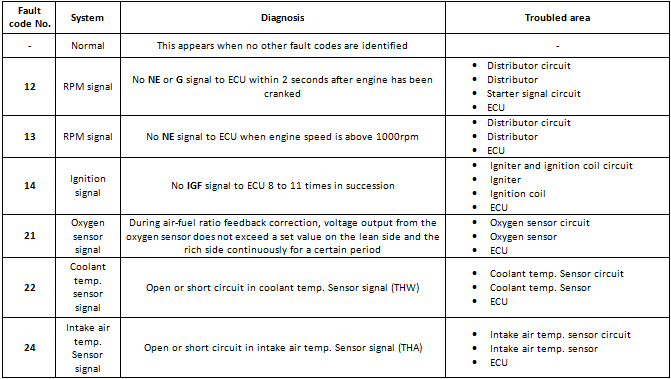
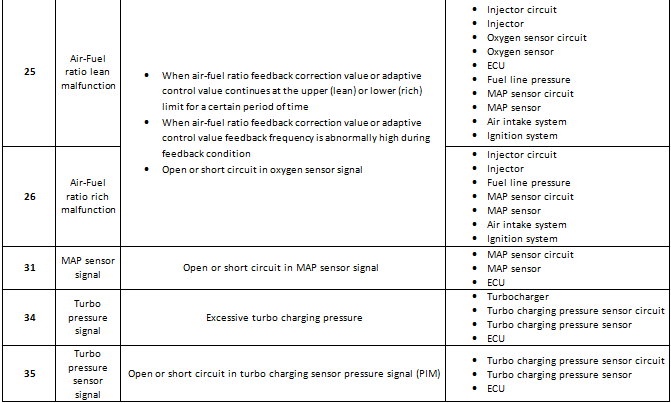
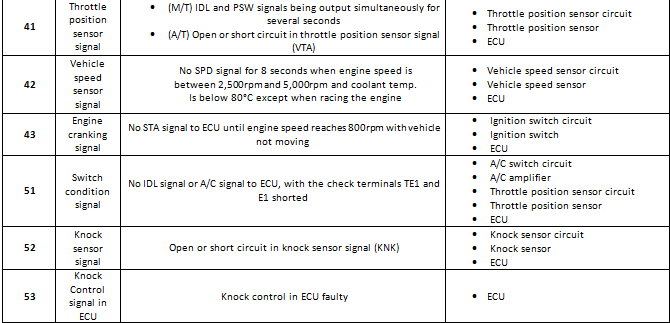
The ECU contains a built in, self-diagnosis system which detects faults within the engine signal network. When the system detects a fault the "CHECK" engine warning lamp in the instrument panel will illuminate.
By analyzing various signals the ECU detects system malfunctions which are related to the various operating parameters of the systems sensors and actuators. The ECU stores fault codes that are associated with the detected malfunctions until the diagnosis system is reset by removing the EFI fuse with the ignition OFF.
An illuminated "CHECK" engine warning lamp in the instrument panel informs the driver that a system malfunction has been detected. The lamp goes out automatically when the malfunction has been cleared.
"CHECK" Engine warning lamp check
The "CHECK" engine warning lamp will illuminate when the ignition switch is in the ON position and the engine is not running.

When the engine is started, the "CHECK" engine warning lamp should go out.
If the lamp remains illuminated, the diagnosis system has detected a system malfunction or abnormality.
Output of Diagnostic Fault Codes
To obtain an output of any stored diagnostic fault codes, proceed as follows:
Initial conditions:
- Battery voltage should be 11v or more
- Throttle valve should be in the fully closed position (TPS IDL points closed)
- Transmission in neutral position (A/T equipped vehicles)
- All accessories switched OFF
- Engine at normal operating temperature
Turn the ignition switch to the ON position without starting the engine.
Short terminals TE1 and E1 of the diagnostic check connector.

Read the diagnostic fault codes as indicated by the number flashes of the "CHECK" engine warning lamp.
Normal system operation (no malfunction detected) will be indicated by the "CHECK" engine warning lamp flashing ON and OFF twice per second.
In the event of one or more malfunctions being detected, the "CHECK" engine warning lamp will blink every 0.5 of a second. The first number of blinks will equal the first digit of a 2-digit diagnostic fault code, after 1.5 second pause, the 2nd number of blinks will equal the 2nd digit of the diagnostic fault code. If there are two or more codes stored, there will be a 2.5 second pause between each code signaled.

After all codes have been signaled there will be a 4.5 second pause and then they will be repeated as long as the terminals TE1 and E1 of the check connector are shorted and the ignition switch remains in the ON position.
In the event of several diagnostic fault codes being stored, the indication will begin from the code with the smaller value and continue in order to the larger.
After the diagnostic check has been completed, remove the short between terminals TE1 and E1 of the check connector and turn the ignition switch to the OFF position.
Cancelling Diagnostic Fault Codes
After the repair of a troubled area, the diagnostic fault codes retained in memory by the ECU must be cleared by removing the fuse "EFI 15A" for 10 seconds or more, depending on ambient temperature (the lower the temperature, the longer the fuse must be left out) with the ignition switch in the OFF position.
Clearing the memory of the ECU can also be done by removing the vehicle battery negative terminal, but in this case, other memory systems (clock, radio etc...) will also be cleared.
If diagnostic fault codes are not cleared from memory, they will be retained by the ECU and appear along with any new codes in the event of any future malfunction.
If it is necessary to work on any engine components that require removal of the vehicles battery, it is recommended that a diagnostic check is first carried out to identify if any diagnostic fault codes are stored before the ECU memory is cleared.
After clearing the memory of the ECU, perform a road test of the vehicle to check that no further malfunctions have been detected and then check that the system normal code is read from the "CHECK" engine warning lamp. If any of the previous diagnostic fault codes have appeared, it will indicate that the troubled area has not been repaired sufficiently.
Diagnosis Indication
When two or more fault codes are indicated, the lowest number (code) will appear first.
All detected fault codes, except codes No.51 and No.53 will be retained in memory by the ECU from the time of detection until the memory has been cleared.
When a malfunction occurs, the "CHECK" engine warning lamp remains illuminated as long as the fault is currently being detected and will go off once normal conditions return. A diagnostic fault code will remain stored in the memory of the ECU (except for codes No.51 and No.53) until the memory is reset, regardless of whether a continuous fault or intermittent fault caused the code to set.
Diagnostic fault codes



